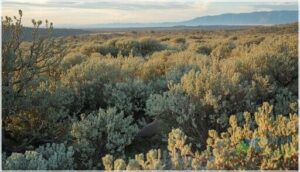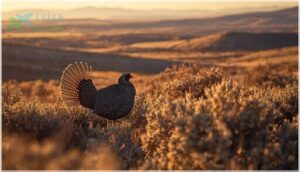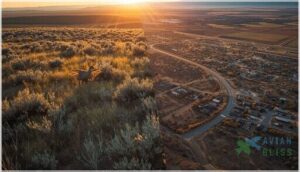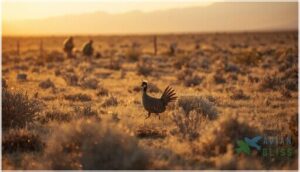This site is supported by our readers. We may earn a commission, at no cost to you, if you purchase through links.
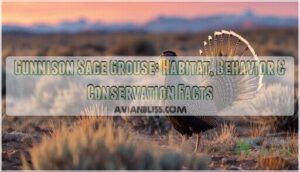
The Gunnison sage grouse exists in only 10% of its historical range. Recognized as a distinct species in 2000, it now carries the weight of a threatened designation under federal law. This ground-dwelling bird clings to survival across scattered sagebrush pockets in Colorado and Utah. The bird’s story reflects a broader pattern of habitat loss across western landscapes.
Males perform elaborate springtime displays on traditional gathering sites. Their inflatable yellow-green neck sacs and fan-like tail feathers create one of nature’s most striking courtship rituals.
Understanding this species means examining its physical traits, habitat needs, and the conservation work aimed at preventing its disappearance from sagebrush ecosystems.
Table Of Contents
- Key Takeaways
- What is The Gunnison Sage-Grouse?
- Habitat and Geographic Range
- Behavior and Life Cycle
- Diet and Foraging Habits
- Conservation Status and Efforts
- Frequently Asked Questions (FAQs)
- Are Gunnison sage grouse?
- What is a Gunnison grouse?
- What habitat does a Gunnison sage grouse need?
- Are Gunnison sage grouse endangered in Colorado?
- What is a sage grouse?
- Where do Gunnison sage grouse live in Utah?
- Are Gunnison sage grouse the same as greater sages?
- When did the Gunnison sage grouse split into two species?
- Where do Gunnison sage grouse live?
- Where can I see Gunnison sage-grouse?
- Conclusion
Key Takeaways
- The Gunnison sage-grouse population has dropped over 60% since the 1950s, with fewer than 4,000 birds remaining in only 10% of their historical range across Colorado and Utah, earning them federal threatened species status in 2014.
- These birds require specific sagebrush habitat conditions year-round, including 25% canopy cover in winter, 10-25% for nesting, and connected seasonal ranges, making them extremely vulnerable to habitat fragmentation and development.
- Males perform elaborate courtship displays on traditional lek sites each spring, but only one or two dominant males successfully mate each season, limiting genetic diversity in already isolated populations.
- Conservation success depends on collaborative management across federal agencies, state wildlife managers, and private landowners who control over 43% of occupied habitat, with efforts focused on habitat restoration, livestock management, and maintaining connectivity between populations.
What is The Gunnison Sage-Grouse?
The Gunnison Sage-Grouse is a rare bird species found only in small pockets of sagebrush country across parts of Colorado and Utah. You’ll recognize these ground-dwelling birds by their stocky build and dramatic courtship displays that happen each spring.
Understanding what makes this species unique helps explain why conservationists work so hard to protect it.
Species Overview and Classification
The Gunnison Sage-Grouse (GUSG) is a distinct species you’ll find only in the American West. Scientists recognized it as separate from the greater sage-grouse in 2000 after studying its genetic uniqueness and behavior.
The taxonomic history reveals Centrocercus minimus belongs to the family Phasianidae. The IUCN classified this species as endangered in 2020 due to severe population declines. These birds are particularly vulnerable to habitat fragmentation.
Key Physical Characteristics
You’ll recognize this bird by its round body shape and surprisingly long tail. Adults measure 18 to 22 inches in length with weights ranging from 35 to 86 ounces. The overall color pattern shows mottled gray-brown plumage with distinctive black areas on the belly and head. Males showcase unique courtship displays on leks.
Key identification features include:
- Tail feathers with cream-colored bars measuring 5-7 mm wide
- Small rounded head contrasting with the chubby body
- Display features like inflatable yellow-green neck sacs in males
Male Vs. Female Identification
You can tell males from females by looking at their plumage differences and display behaviors. Males show white breast feathers, a black belly, and yellow air sacs during courtship. They also have long black filoplumes on their neck. Females wear mottled brown and gray feathers for camouflage. Size variations exist too—males reach 22 inches, while females measure around 18 inches.
| Feature | Male | Female |
|---|---|---|
| Plumage | White breast, black belly, yellow air sacs | Mottled brown and gray |
| Filoplumes | Long, thick, black neck plumes | Absent or very short |
| Display | Elaborate strutting and tail fanning | No courtship display |
| Size | Up to 22 inches, 2.2–5.3 lbs | About 18 inches, 2.2–4.4 lbs |
Size Comparison With Similar Birds
Understanding bird size comparison helps you grasp just how big these ground-dwellers really are. The Gunnison sage-grouse sits between a Ring-necked Pheasant and a Wild Turkey in overall measurements. Males reach 22 inches and weigh up to 5.4 pounds, while Greater Sage-Grouse males measure 27–34 inches and can hit 7.3 pounds.
Key size comparisons include:
- Gunnison sage-grouse are roughly 30% smaller than Greater Sage-Grouse in both length and weight
- Males weigh 2.2–5.3 pounds; females stay lighter at 2.2–4.4 pounds, showing sexual dimorphism
- Their wingspan spans 24–30 inches, exceeding most native grouse except their larger relatives
- Regional variation appears in Colorado populations, with Gunnison Basin birds weighing less than North Park residents
- They’re crow-sized with a chubby body shape that distinguishes them from sleeker grouse species
Habitat and Geographic Range
The Gunnison Sage-Grouse lives in a small corner of the American West where sagebrush stretches across the landscape. You’ll find this bird only in parts of Colorado and Utah, where the right mix of plants and open space meet its needs.
Understanding where these birds live and what they require helps explain why their numbers have dropped so dramatically.
Preferred Sagebrush Ecosystems
You need healthy sagebrush habitat to protect Gunnison Sage-Grouse populations. Big sagebrush dominates these ecosystems with canopy cover exceeding 25%. Sagebrush composition includes at least three native species providing year-round resources. Vegetative structure requires shrubs between 30 and 80 centimeters tall. Soil factors like loamy texture support sagebrush productivity.
Spatial connectivity depends on continuous stands spanning 1,400 hectares. Ecosystem resilience resists invasive grasses.
Habitat conservation efforts target these features. Habitat restoration tackles habitat loss affecting survival.
Distribution in Colorado and Utah
Across Colorado and Utah, you’ll find Gunnison Sage-Grouse in only 10% of their historical range. Seven populations occupy Colorado’s western counties, while one small population persists near Monticello, Utah. The Gunnison Basin holds 88% of all remaining birds.
Habitat loss and habitat fragmentation have isolated these groups since the early 1900s. Management responsibility falls largely to federal agencies controlling 54% of occupied sagebrush habitat.
Habitat Requirements for Survival
Your Gunnison Sage-Grouse habitat must provide specific conditions year-round. These birds depend on precise vegetation characteristics that shift with seasons.
- Canopy Cover: Nesting areas need 10–25% sagebrush cover, while winter habitat requires over 25%
- Herbaceous Groundcover: Nest sites demand 10–40% perennial grass and 5–40% forb cover for chick survival
- Spatial Configuration: Home ranges must connect seasonal habitats while avoiding roads and disturbances
Impact of Human Activity on Habitat
Human activity has shrunk Gunnison Sage-Grouse habitat to just 7% of its historic range. Energy development fragments breeding areas when disturbance exceeds 5% of the landscape. Agricultural conversion removes sagebrush on private lands, while urban expansion brings roads and noise that disrupt nesting.
Habitat loss and degradation continue despite conservation efforts because policy limitations don’t restrict development in critical areas. Over 43% of occupied habitat sits on private property, where habitat restoration projects face significant challenges.
Behavior and Life Cycle
The Gunnison Sage-Grouse follows a fascinating yearly pattern tied closely to the seasons and survival needs of the species. Males are famous for their elaborate mating displays that happen each spring on traditional gathering grounds.
Understanding their behavior gives you insight into why protecting their habitat matters so much for keeping these birds around.
Courtship and Lekking Displays
You’ll witness something striking when male Gunnison Sage-Grouse gather at their traditional lek sites each spring. These courtship displays begin in late February and continue through April.
Males perform distinctive strut displays at slower tempos than other grouse. They fan their tails, puff their chests, and produce unique popping vocalizations. Female mate choice drives this mating ritual. Only one or two dominant males successfully mate each season.
Lek site fidelity remains strong across decades, but disturbance vulnerabilities threaten these essential breeding grounds.
Social Structure and Flocking
When you observe these birds outside the breeding season, you’ll notice their behavior shifts dramatically. Winter flocking brings large groups together, sometimes exceeding 200 individuals at key sites. Males and females generally separate into different groups during this time.
Social hierarchy becomes clear at leks where dominant males claim central territories and secure most mating opportunities. Regional variation affects flock size, with the Gunnison Basin supporting the largest concentrations.
Nesting and Reproduction
After establishing social groups, females shift focus to nesting. Nest site selection heavily favors sagebrush cover around 30–40 cm tall.
Clutch size averages 6–7 eggs per nest, with the incubation period lasting 25–29 days. Chick survival faces tough odds—40–60% mortality occurs within two weeks of hatching.
Reproductive threats from predation, habitat loss, and drought continue reducing breeding success across all populations.
Seasonal Movements and Dispersal
Beyond nesting, you’ll see Gunnison Sage-Grouse shift across different landscapes throughout the year. Movement patterns link breeding grounds to winter habitats, with common journeys exceeding 18 miles. Habitat connectivity matters—river valleys create dispersal barriers that drive population isolation. Conservation efforts now track these seasonal shifts to protect critical pathways.
Here’s what shapes their migration triggers and winter flocking behavior:
- Late May through early August: Females lead chicks to higher elevation summer feeding areas as spring habitats dry out.
- Mid-October through late November: Autumn peak migration to winter habitats begins, with birds seeking low elevations where sagebrush protrudes above shallow snow.
- Yearling dispersal distances: Young birds travel median distances of 4.6 to 5.5 miles from hatching sites to breeding grounds, with males moving farther than females.
- Winter flocks: Groups segregate by sex, generally under 50 birds but occasionally reaching 100 individuals in suitable sagebrush communities.
- Site fidelity patterns: Individual grouse return to consistent seasonal ranges year after year, though large agricultural areas fragment population dynamics.
Diet and Foraging Habits
The Gunnison Sage-Grouse depends heavily on sagebrush and other plants to survive throughout the year. What they eat changes with the seasons, and their digestive system is built differently than most grouse species.
You’ll find their foraging habits are simple but effective as they walk through their habitat searching for food at ground level.
Primary Food Sources
When you’re looking at the Gunnison sage-grouse diet, you’ll find it’s heavily built on sagebrush leaves. These plants form the foundation of what they eat year-round.
Forbs like dandelions and legumes add protein during spring and summer. Insects provide essential nutrition for chicks in their first weeks.
Adults also eat sagebrush buds and flowers when available for added nutrients.
Seasonal Dietary Changes
The Gunnison sage-grouse diet shifts dramatically with the seasons. In winter, sagebrush makes up 100% of what they eat. By autumn, you’ll notice them shifting back toward sagebrush as other plant material becomes scarce.
Spring brings a welcome change as forbs and insects become available. Summer sees the highest insect focus, especially for growing chicks.
Age-related differences also affect feeding behavior throughout these seasonal changes.
Foraging Strategies and Techniques
You’ll find Gunnison sage-grouse foraging in small groups during early morning and late afternoon. Their feeding behavior focuses on ground-level browsing for plant material and insects. Group foraging provides better predator detection, though individuals spend less time eating.
Habitat fragmentation forces longer travel distances, while deep snow reduces foraging efficiency. Dietary adaptations allow birds to shift insect consumption based on seasonal needs and habitat conditions.
Conservation Status and Efforts
The Gunnison Sage-Grouse is in serious trouble. Only a few thousand birds remain in the wild, and their numbers keep dropping.
Understanding their conservation status helps explain why so many groups are working together to save this species.
Population Decline and Threats
You’re witnessing one of the most dramatic population declines in North American bird history. Gunnison sage-grouse numbers have plummeted over 60 percent since the 1950s. Today fewer than 4,000 individuals remain in isolated pockets across Colorado and Utah.
The Gunnison Sage-Grouse has suffered one of North America’s most dramatic bird declines, losing over 60 percent of its population since the 1950s
Habitat fragmentation and degradation drive this endangered species toward extinction. Climate impacts worsen drought conditions while disease outbreaks and invasive species create additional conservation challenges for remaining populations.
Federally Threatened Designation
After years of decline, the U.S. Fish and Wildlife Service officially designated the Gunnison Sage-Grouse as a threatened species under the Endangered Species Act in November 2014.
This ESA listing established critical habitat across 1.4 million acres in Colorado and Utah.
The designation requires federal agencies to protect breeding grounds and implement management actions that support population distribution across remaining habitats while coordinating with state policy frameworks.
Ongoing Conservation Programs
Conservation programs now target multiple fronts to support recovery. Habitat restoration removes encroaching conifers and rebuilds degraded meadows across over 44 acres in Colorado. Land protection efforts safeguard over 1,300 acres of critical sagebrush habitat.
Population monitoring through radio telemetry tracks survival and movement patterns. Translocation projects boost genetic diversity in isolated populations.
Public awareness campaigns engage communities through education programs and volunteer opportunities, supporting Gunnison sage-grouse conservation plan goals.
Collaborative Management Strategies
You’ll see recovery depends on teamwork across boundaries. Agency partnerships unite federal bodies like the U.S. Fish and Wildlife Service with state wildlife managers and private landowners who control over 43% of occupied habitat.
Landowner incentives encourage voluntary conservation through Safe Harbor Agreements. Adaptive grazing adjusts livestock management based on habitat health.
Data sharing through standardized monitoring ensures interagency collaboration drives the Recovery Plan forward with coordinated habitat restoration and wildlife management strategies.
Frequently Asked Questions (FAQs)
Are Gunnison sage grouse?
You might wonder if these birds are truly a separate species. Gunnison sage-grouse are indeed distinct from Greater Sagegrouse, confirmed by genetic studies showing no gene flow between them since
What is a Gunnison grouse?
A Gunnison grouse is a rare ground-dwelling bird native to sagebrush ecosystems in southwestern Colorado and southeastern Utah.
You can recognize males by their distinctive white breast and yellow air sacs during courtship displays.
What habitat does a Gunnison sage grouse need?
Think of avian habitat as a survival blueprint. You’ll need sagebrush canopy cover between 12% and 43%, a herbaceous understory rich in forbs, riparian corridors for chicks, and winter food access above snowpack.
Habitat fragmentation threatens these requirements constantly.
Are Gunnison sage grouse endangered in Colorado?
Yes. Colorado recognizes this species as federally threatened and a state special concern.
Population viability remains fragile despite conservation efforts, with habitat connectivity and recovery challenges limiting species recovery.
Future outlook requires expanded protections addressing threats to sage-grouse population survival.
What is a sage grouse?
You can’t judge a book by its cover, but with sage grouse, size tells the story.
These native North American grouse are the largest in their family, classified under Centrocercus within Phasianidae.
Where do Gunnison sage grouse live in Utah?
You’ll find Gunnison sage-grouse habitat only in San Juan County. The sagebrush steppe spans elevations from 5,900 to 9,000 feet.
Range contraction left this conservation preserve near Monticello as Utah’s single remaining population.
Are Gunnison sage grouse the same as greater sages?
No, they aren’t the same. The Gunnison sage-grouse was recognized as a distinct avian species in 2000 after researchers confirmed genetic divergence and morphological differences separating it from the greater sage-grouse.
When did the Gunnison sage grouse split into two species?
DNA testing revealed the split in 2000 when scientists recognized genetic evidence and geographic separation from greater sage-grouse.
This species recognition marked the first new U.S. bird since the 1800s, impacting conservation efforts considerably.
Where do Gunnison sage grouse live?
Home is where the sagebrush grows. You’ll find Gunnison sage-grouse in southwestern Colorado and southeastern Utah.
Their habitat fragmentation limits range to about seven counties, with elevation preferences between 5,900 and 9,000 feet.
Where can I see Gunnison sage-grouse?
You can observe these birds at the Waunita Watchable Wildlife Site near Gunnison Basin, the only legal public viewing location.
The site features viewing infrastructure, including a trailer, and strict conservation restrictions protecting the threatened Gunnison sagegrouse habitat.
Conclusion
Without immediate action, the Gunnison sage grouse could vanish entirely from the western landscape. Every remaining bird matters when populations hover near extinction levels.
You’ve now seen how habitat destruction, human development, and fragmented sagebrush ecosystems threaten this species’ survival.
Conservation efforts depend on collaborative management and public awareness. The fate of these birds rests in decisions made today. Their survival requires your understanding and support of ongoing protection measures across Colorado and Utah.
- https://defenders.org/wildlife/sage-grouse
- https://cpw.state.co.us/species/gunnison-sage-grouse
- https://eplanning.blm.gov/public_projects/2019031/200526603/20121199/251021179/GUSG%20ROD%20ARMPA%20October%202024.pdf
- https://westernwatersheds.org/2023/11/gunnison-sage-grouse-groups-pan-draft-of-preferred-federal-plan-as-surprisingly-weak/
- https://siskadee.org/threats/

